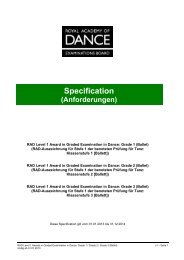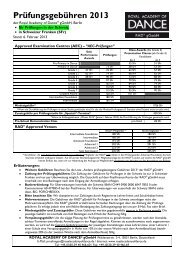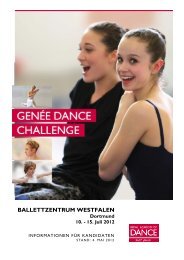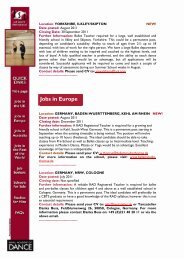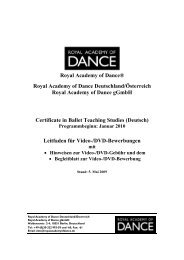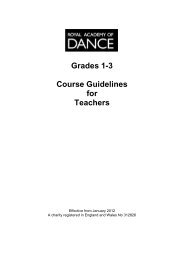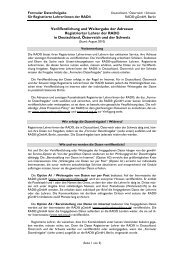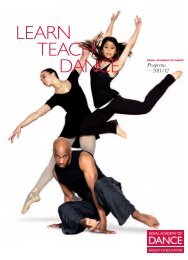QCF Grades 1-3 Specification - Royal Academy of Dance
QCF Grades 1-3 Specification - Royal Academy of Dance
QCF Grades 1-3 Specification - Royal Academy of Dance
- No tags were found...
Create successful ePaper yourself
Turn your PDF publications into a flip-book with our unique Google optimized e-Paper software.
<strong>Specification</strong>RAD Level 1 Award in Graded Examination in <strong>Dance</strong>: Grade 1 (Ballet)RAD Level 1 Award in Graded Examination in <strong>Dance</strong>: Grade 2 (Ballet)RAD Level 1 Award in Graded Examination in <strong>Dance</strong>: Grade 3 (Ballet)(Qualifications accredited in England, Wales and Northern Ireland)<strong>Grades</strong> 1-3 Class Awards and Solo Performance AwardsThis <strong>Specification</strong> is valid from 1 March 2013 to 31 December 2013RAD Level 1 Awards in Graded Examination in <strong>Dance</strong>: Grade 1 / Grade 2 / Grade 3 (Ballet) page 1Valid 01 March 2013
The <strong>Royal</strong> <strong>Academy</strong> <strong>of</strong> <strong>Dance</strong> (RAD) is an international teacher education and awardingorganisation for dance. It was established in 1920 as the Association <strong>of</strong> Operatic Dancing <strong>of</strong>Great Britain, granted a <strong>Royal</strong> Charter in 1936 and renamed the <strong>Royal</strong> <strong>Academy</strong> <strong>of</strong> Dancing.In 1999 it became the <strong>Royal</strong> <strong>Academy</strong> <strong>of</strong> <strong>Dance</strong>.Vision:Leading the world in dance education and training, the <strong>Royal</strong> <strong>Academy</strong> <strong>of</strong> <strong>Dance</strong> will berecognised internationally for the highest standards <strong>of</strong> teaching and learning. As thepr<strong>of</strong>essional membership body for dance teachers it will inspire and empower danceteachers and students, members, and staff to make innovative, artistic and lastingcontributions to dance and dance education throughout the world.Mission:To promote and enhance knowledge, understanding and practice <strong>of</strong> dance internationally byeducating and training teachers and students and by providing examinations to rewardachievement, so preserving the rich, artistic and educational value <strong>of</strong> dance for futuregenerations.We will:• Communicate openly• Collaborate within and beyond the organisation• Act with integrity and pr<strong>of</strong>essionalism• Deliver quality and excellence• Celebrate diversity and work inclusively• Act as advocates for danceExaminations Department<strong>Royal</strong> <strong>Academy</strong> <strong>of</strong> <strong>Dance</strong>36 Battersea SquareLondon SW11 3RA +44 (0)20 7326 8000 exams@rad.org.uk www.rad.org.uk/examinations© <strong>Royal</strong> <strong>Academy</strong> <strong>of</strong> <strong>Dance</strong> 2013ROYAL ACADEMY OF DANCE, RAD, RAD PRE-PRIMARY IN DANCE and RAD PRIMARY IN DANCE areregistered trademarks® <strong>of</strong> the <strong>Royal</strong> <strong>Academy</strong> <strong>of</strong> <strong>Dance</strong>. RAD INTERMEDIATE FOUNDATION, RADINTERMEDIATE, RAD CLASS AWARD, RAD SOLO PERFORMANCE AWARD and CBTS are unregisteredtrademarks <strong>of</strong> the <strong>Royal</strong> <strong>Academy</strong> <strong>of</strong> <strong>Dance</strong>. The use or misuse <strong>of</strong> the trademarks or any other content <strong>of</strong> thispublication, without prior written permission from the <strong>Royal</strong> <strong>Academy</strong> <strong>of</strong> <strong>Dance</strong>, is strictly prohibited.The <strong>Royal</strong> <strong>Academy</strong> <strong>of</strong> <strong>Dance</strong> is incorporated in England as a <strong>Royal</strong> Charter corporation. It is registered as aCharity in England and Wales No. 312826.RAD Level 1 Awards in Graded Examination in <strong>Dance</strong>: Grade 1 / Grade 2 / Grade 3 (Ballet) page 2Valid 01 March 2013
Contents1 Objectives, aims and philosophy ............................................. 42 Learning outcomes and assessment criteria ........................... 73 Syllabus content ....................................................................... 104 How marks are awarded .......................................................... 145 Awarding and reporting ............................................................ 216 Resources ................................................................................ 23This <strong>Specification</strong> should be read in conjunction with the document:Examinations Information, Rules and Regulationsavailable on request from the RAD Examinations Departmentand on the RAD website: www.rad.org.ukRAD Level 1 Awards in Graded Examination in <strong>Dance</strong>: Grade 1 / Grade 2 / Grade 3 (Ballet) page 3Valid 01 March 2013
1 Objectives, aims, and philosophy1.1 Summary1.1.1 These Graded Examinations constitute Level 1 <strong>of</strong> the RAD's Graded syllabusprovision in the performance <strong>of</strong> ballet. They are the first three in a suite <strong>of</strong> eightgrades from Grade 1 to Grade 8. An entry pathway to Grade 1 is provided by theRAD’s Primary in <strong>Dance</strong> syllabus.1.1.2 <strong>Grades</strong> 1-3 are <strong>of</strong>fered as an Examination, Class Award and a Solo PerformanceAward. Only the Examinations are included on the Register <strong>of</strong> RegulatedQualifications.1.2 Objectives (Graded Examinations)1.2.1 Following on from Primary in <strong>Dance</strong>, the knowledge and skills gained throughsuccessful completion <strong>of</strong> these qualifications provide a basis for progression tosubsequent Graded Examinations in <strong>Dance</strong> (<strong>Grades</strong> 4-8). They also constitute apreparation for RAD Vocational Graded Examinations in <strong>Dance</strong>, and for Graded andVocational Graded Examinations in a range <strong>of</strong> dance genres <strong>of</strong>fered by otherAwarding Organisations.1.2.2 Graded and Vocational Graded Examinations in <strong>Dance</strong> provide the basis <strong>of</strong> courses<strong>of</strong> study which lead to recognised achievement at a high level in dance performance.The higher levels <strong>of</strong> these qualifications are accepted as benchmarks <strong>of</strong> achievementby Vocational Schools which are attended by the majority <strong>of</strong> young dancers intendingto enter the pr<strong>of</strong>ession. They are also taken into account by universities and otherHE institutions <strong>of</strong>fering degree courses and programmes in dance and dance teachereducation (such as the RAD itself). Such qualifications also facilitate or aidprogression to workplace opportunities such as: pr<strong>of</strong>essional dancer, pr<strong>of</strong>essionaldance teacher, pr<strong>of</strong>essional choreographer, pr<strong>of</strong>essional dance notator, pr<strong>of</strong>essionaldance historian, lecturer in dance, and facilitator in community dance.1.2.3 Achievement in dance contributes to a learner’s all-round achievement, as it helps todevelop competencies such as motor control, health and safety awareness,self-expression, physical fitness and stamina, discipline, mental ability andconfidence.1.3 Aims1.3.1 The aims <strong>of</strong> the Graded Examination syllabus are to:promote the study <strong>of</strong> ballet and related dance disciplines as a leisure and/orvocational activityprovide a means <strong>of</strong> measuring the acquisition <strong>of</strong> technical, musical andperformance skills in ballet and related dance disciplinespromote and encourage enjoyment <strong>of</strong> movement as a form <strong>of</strong> physical exerciseprovide all candidates, particularly children and young people, with anopportunity <strong>of</strong> experiencing dance accompanied by live and recorded musicRAD Level 1 Awards in Graded Examination in <strong>Dance</strong>: Grade 1 / Grade 2 / Grade 3 (Ballet) page 4Valid 01 March 2013
encourage personal self-confidence and group awareness through theexperience <strong>of</strong> dancing solo, with partners and in small groupsaid the development <strong>of</strong> a general appreciation <strong>of</strong> music through dancing tovarious musical styles and rhythmic patternsmotivate students by providing a series <strong>of</strong> clearly defined goals which havebeen structured to reflect the principles <strong>of</strong> safe dance practiceprovide teachers with a means by which to measure the individual progress <strong>of</strong>their students.1.3.2 A course <strong>of</strong> study based on the Graded syllabus is intended to provide students with:an increasing ability to demonstrate practical knowledge <strong>of</strong> the dancedisciplines <strong>of</strong> ballet and charactera graduated measure <strong>of</strong> attainment against specific criteriaincreasing self-confidence through the learning, memorising and performing <strong>of</strong>prescribed sequences <strong>of</strong> movement, studies and dancesan awareness and understanding <strong>of</strong> working with othersan appreciation, through practical experience, <strong>of</strong> contrasting dance disciplineswith their accompanying music.1.4 Philosophy1.4.1 The underlying philosophy <strong>of</strong> <strong>Grades</strong> 1-3 is to provide teachers and students with anexamination syllabus that will encourage the development <strong>of</strong> an appropriate andsound technique, relevant for the ballet world <strong>of</strong> today. Through the stated elements<strong>of</strong> assessment, the syllabus identifies the necessary skills that underpin securetechnique, such as core stability, weight placement, turnout and line, while continuingto recognise and reward the candidates’ awareness <strong>of</strong> artistry and dynamics.Musically inspired exercises and dances will motivate students preparing for theseexaminations, Class Awards and Solo Performance Awards to acquire a well roundedunderstanding <strong>of</strong> ballet, and will promote joy in movement, creative interpretation,and a sense <strong>of</strong> dance and performance quality.1.5 Fitness for purpose1.5.1 A qualification will only be fit for purpose if that qualification, as far as possible,secures the requirements <strong>of</strong>validityreliabilitycomparabilitymanageabilityminimising bias1.5.2 The RAD aims to secure these requirements by the following means:appointing Examiners who are subject experts, and who demonstrate theirsuitability for the role <strong>of</strong> assessor via the outcomes <strong>of</strong> a rigorous and extensivetraining programmeRAD Level 1 Awards in Graded Examination in <strong>Dance</strong>: Grade 1 / Grade 2 / Grade 3 (Ballet) page 5Valid 01 March 2013
monitoring the work <strong>of</strong> Examiners by holding annual training seminars,organising periodic moderation exercises, organising standardisation visits, andproducing an Annual Review for each Examinercarrying out reviews <strong>of</strong> syllabus content and marking methodologies which leadthe way in defining best practice in dance assessmentcarrying out quality assurance checks on results, including statistical analysis <strong>of</strong>marks and adjustment where appropriatehaving policies and procedures related to diversity and equality which seek tomaximise access to examination, identify and mitigate barriers, and ensure thatall candidates are assessed in the same way regardless <strong>of</strong> their personalcharacteristicssetting out clearly how Reasonable Adjustments and Special Considerationmay be applied in relation to examinationsidentifying conflicts <strong>of</strong> interest and setting out how these are managed.The full policies and procedures related to the above matters are available onrequest.1.6 Required knowledge, skills and understanding1.6.1 No previous attainment in dance is necessary in order to enter for the Examinationsor Class Awards. Candidates entering for a Solo Performance Award are required tohave passed the previous level <strong>of</strong> Examination (see Examinations Information, Rulesand Regulations, Section 4.2.3).1.6.2 An indication <strong>of</strong> required knowledge, skills and understanding is provided by thecontent <strong>of</strong> the preceding level in the Graded structure: i.e. Primary in <strong>Dance</strong> forGrade 1; Grade 1 for Grade 2; and Grade 2 for Grade 3. Please consult the relevant<strong>Specification</strong>s for more information.1.7 Further information1.7.1 Further information about policies and procedures related to RAD Examinations,rules and regulations, and information about recognition and accreditation, may befound in the document Examinations Information, Rules and Regulations, availableon request from the RAD Examinations Department and on the RAD website(www.rad.org.uk).RAD Level 1 Awards in Graded Examination in <strong>Dance</strong>: Grade 1 / Grade 2 / Grade 3 (Ballet) page 6Valid 01 March 2013
2 Learning outcomes and assessmentcriteria2.1 The learning outcomes and assessment criteria set out in 2.2 – 2.4 below are takenfrom the units against which the Graded Examinations are mapped on theQualifications and Credit Framework (<strong>QCF</strong>) in England, Wales and Northern Ireland.For more information, see Examinations Information, Rules and Regulations,Section 2.Learning outcomes describe what a learner should know, understand or be able to doon completion <strong>of</strong> a learning process, defined in terms <strong>of</strong> knowledge, skills andcompetence.Assessment criteria specify the standard a learner is expected to meet in order todemonstrate that the learning outcomes have been achieved.2.2 Grade 1 ExaminationLearning outcomesThe learner will:be able to perform simple movementsequences showing an awareness <strong>of</strong>basic techniques in balletbe able to perform simple movementsequences showing an awareness <strong>of</strong>musicality in balletbe able to show an awareness <strong>of</strong>performance in balletAssessment criteriaThe learner can:demonstrate a basic knowledge <strong>of</strong> thevocabulary <strong>of</strong> balletdemonstrate basic technical skillsdemonstrate a basic sense <strong>of</strong> appropriatetiming and rhythmdemonstrate a basic responsiveness tomusicdemonstrate a basic use <strong>of</strong> expressiondemonstrate a basic awareness <strong>of</strong> anaudience2.3 Grade 2 ExaminationLearning outcomesThe learner will:be able to perform simple movementsequences showing an awareness <strong>of</strong>basic techniques in balletbe able to perform simple movementsequences showing an awareness <strong>of</strong>musicality in balletbe able to show an awareness <strong>of</strong>performance in balletAssessment criteriaThe learner can:demonstrate knowledge andunderstanding <strong>of</strong> the vocabulary <strong>of</strong> balletdemonstrate technical skillsdemonstrate a sense <strong>of</strong> appropriate timingand rhythmdemonstrate a responsiveness to musicdemonstrate a basic use <strong>of</strong> expression asappropriatedemonstrate an awareness <strong>of</strong> anaudienceRAD Level 1 Awards in Graded Examination in <strong>Dance</strong>: Grade 1 / Grade 2 / Grade 3 (Ballet) page 7Valid 01 March 2013
2.4 Grade 3 ExaminationLearning outcomesThe learner will:be able to perform simple movementsequences showing an awareness <strong>of</strong>basic techniques in balletbe able to perform simple movementsequences showing an awareness <strong>of</strong>musicality in balletbe able to show an awareness <strong>of</strong>performance in balletAssessment criteriaThe learner can:demonstrate knowledge andunderstanding <strong>of</strong> the vocabulary <strong>of</strong> balletdemonstrate consistent technical skillsdemonstrate a basic understanding <strong>of</strong>appropriate timing and rhythmdemonstrate a responsiveness to musicappropriatelydemonstrate the use <strong>of</strong> expressionappropriatelydemonstrate an appropriate awareness <strong>of</strong>an audience2.5 A candidate who has successfully completed a course <strong>of</strong> study based on <strong>Grades</strong> 1, 2and 3 will be able to:Techniquedemonstrate knowledge and understanding <strong>of</strong> the fundamental and relevanttechnique required at Level 1demonstrate co-ordination, control and accuracy in a range <strong>of</strong> sequencesperform with an awareness <strong>of</strong> lineperform with spatial awareness <strong>of</strong> the body in travelling movements and turningactionsdemonstrate an awareness <strong>of</strong> the appropriate dynamic values in the performance<strong>of</strong> the vocabulary.Musicperform with correct and accurate timing and appropriate response to the music.Performanceperform with expression and communication.2.6 In the examination, candidates will be assessed on their ability to:perform a series <strong>of</strong> prepared ballet exercises which require the ability todemonstrate secure posture, correct weight placement, co-ordination <strong>of</strong> thewhole body, control, line, spatial awareness and dynamic valuesdance, throughout the examination, in time to the music and showresponsiveness to the musicdance, throughout the examination, with expression and communicationperform two dances which require the candidate to demonstrate all the aboveaspects <strong>of</strong> Technique, Music and Performance.2.7 In progressing through these Level 1 qualifications, candidates are expected todemonstrate an increasing vocabulary <strong>of</strong> steps, and an increasing awareness andmastery <strong>of</strong> dance technique. Candidates are expected to demonstrate knowledge <strong>of</strong>vocabulary as defined by the syllabus content. An understanding <strong>of</strong> technique isreflected in the ability to co-ordinate movements to produce combinations <strong>of</strong> stepswith appropriate quality <strong>of</strong> movement (i.e. precision and control), within the range <strong>of</strong>the candidates’ physical capacity.RAD Level 1 Awards in Graded Examination in <strong>Dance</strong>: Grade 1 / Grade 2 / Grade 3 (Ballet) page 8Valid 01 March 2013
2.8 Candidates are required to communicate an increasing confidence in performance.They should be able to interpret music and display a developing sensitivity to musicalcontent and style. Candidates' performances should communicate a developingspatial awareness, an ability to work with others, and responsiveness to an audience.2.9 Class Awards and Solo Performance AwardsIn so far as they are defined by the content <strong>of</strong> the syllabus, learning outcomes andassessment criteria for Class Awards and Solo Performance Awards may beconsidered to be in line with those for the Examinations as detailed above. Theassessment system for Class Awards is formative in nature rather than summative,and is intended to give a broad overview <strong>of</strong> the candidate’s achievement andprogress to date as observed by the Examiner. The assessment system for SoloPerformance Awards is similar to that <strong>of</strong> the Examinations, but the content <strong>of</strong> theAward consists only <strong>of</strong> <strong>Dance</strong>s, and is thus narrower in scope.RAD Level 1 Awards in Graded Examination in <strong>Dance</strong>: Grade 1 / Grade 2 / Grade 3 (Ballet) page 9Valid 01 March 2013
3 Syllabus content3.1 General3.1.1 <strong>Grades</strong> 1-3 are <strong>of</strong>fered as an Examination, Class Award and a Solo PerformanceAward. Only the Examinations are included on the Register <strong>of</strong> RegulatedQualifications.3.1.2 Detailed descriptions <strong>of</strong> the set exercises and dances for each Grade are publishedin the Set Exercises and <strong>Dance</strong>s book, formerly known as the Syllabus (seeSection 6, Resources below) which may be purchased from RAD Enterprises Ltd,through mail order, personal shopping or from its website: www.radenterprises.co.uk3.1.3 Male and female candidates are examined or presented together.3.1.4 For more information about preparation, requirements, and procedure, seeExaminations Information, Rules and Regulations, Sections 4 and 5.3.2 Graded Examinations3.2.1 Candidates will be examined through the performance <strong>of</strong> the prescribed examinationcontent including items choreographed by the candidates and their teacher. Allexercises should be prepared, and two dances chosen from the options available forthe Grade, as shown in the formats below.3.2.2 Candidates are normally seen in groups <strong>of</strong> four; however smaller groups will beaccepted when required by the total number <strong>of</strong> candidates entered. Candidatesshould be prepared to dance solo and in combination <strong>of</strong> groups, i.e. one, two, threeor four at a time, as indicated.3.2.3 Grade 1: Examination content (format)ContentTechnique 1Warm upLegs and armsTechnique 2Port de brasDemi-pliésTransfer <strong>of</strong> weightWalksTechnique 3SautésPetit jetés and spring pointsGalopsTechnique 4SpringsStep hop and parallel assemblé<strong>Dance</strong>: A or BCharacter <strong>Dance</strong>: C or DRévérenceFormat (with four candidates)all togethertwo at a timeall togetherall togethertwo at a timetwo at a time continuouslyall togethertwo at a timetwo at a time or all together twice throughtwo at a timeone at a time continuouslyone at a timeone at a timeall togetherRAD Level 1 Awards in Graded Examination in <strong>Dance</strong>: Grade 1 / Grade 2 / Grade 3 (Ballet) page 10Valid 01 March 2013
3.2.4 Grade 2: Examination content (format)ContentTechnique 1PliésBattements tendusPreparation for grands battementsTechnique 2Port de brasFondusTransfer <strong>of</strong> weightAdageTechnique 3Sautés and soubresautsEchappés sautés and petits jetésGalopsTechnique 4Turns and parallel assemblésGrand allegro<strong>Dance</strong>: A or BCharacter <strong>Dance</strong>: C or DRévérenceFormat (with four candidates)all togetherall togetherall togethertwo at a timetwo at a time continuouslytwo at a time or all together twice throughtwo at a timetwo at a timetwo at a timetwo at a time or all together twice throughone at a time continuouslytwo at a time continuouslyone at a timeone at a timeall together3.2.5 Grade 3: Examination content (format)ContentTechnique 1PliésBattements tendus and battements glissésBattements fondus and développés devantGrands battements A – devant OR Grandsbattements B – second and derrièreTechnique 2Port de brasRonds de jambe à terreTransfer <strong>of</strong> weightAdageTechnique 3Sautés and changementsGlissades, sissonnes and assemblésPosés and temps levésTechnique 4TurnsGrand allegro<strong>Dance</strong>: A, B or CCharacter <strong>Dance</strong>: D or ERévérenceFormat (with four candidates)all togetherall togetherall togetherall togethertwo at a timeall togethertwo at a time or all together twice throughtwo at a timetwo at a timetwo at a timetwo at a timeone at a time continuouslyone at a time continuouslyone at a timeone at a timeall togetherRAD Level 1 Awards in Graded Examination in <strong>Dance</strong>: Grade 1 / Grade 2 / Grade 3 (Ballet) page 11Valid 01 March 2013
3.3 Class Awards3.3.1 Class Awards are conducted by the teacher or an assistant, with the Examinerassessing the class. A maximum <strong>of</strong> eight candidates can be presented at any onetime.3.3.2 The content for Class Awards is the same as for Graded Examinations (see above,Sections 3.2.3 – 3.2.5) except that candidates present one dance rather than two.3.3.3 Teachers should arrange candidates in groupings that are appropriate for the studiospace, allow the Examiner to clearly see all the candidates and fit within the allocatedtime frame.3.3.4 The <strong>Dance</strong> should be shown two at a time and continuous diagonals two by two.3.4 Solo Performance Awards3.4.1 These are assessed by the Examiner. Candidates can be entered in sets <strong>of</strong> up t<strong>of</strong>our.3.4.2 Candidates entering for a Solo Performance Award need to have passed the previousGraded Examination (or the equivalent or any higher level <strong>of</strong> examination, includingVocational Graded Examinations). See Examinations Information, Rules andRegulations, Section 4.2.3.3.4.3 Candidates are required to present three dances, each shown as a solo. Two <strong>of</strong>these must be taken from the corresponding Graded Examination syllabus. The thirddance may be either:(a) taken from the corresponding graded syllabus; or(b) free choice, in any dance genre or style.3.4.4 In the case <strong>of</strong> (b) above, the dance should be original, may not belong to anypublically recognised third party (e.g. another dance organisation), and may not havebeen previously published in any form. In most cases we expect it to have beenchoreographed by the teacher / candidate, although it is also possible to use dancesfrom other sources (e.g. choreographed by a friend / colleague) provided this is donewithin the constraints set out above, and with the permission <strong>of</strong> the choreographer.3.4.5 Where the third dance is a free choice, the degree <strong>of</strong> challenge in the movementskills demanded by the choreography must be broadly comparable to that <strong>of</strong> the setdances. If in the opinion <strong>of</strong> the Examiner this is not the case, this may be reflected inthe marking.3.4.6 The teacher is responsible for the use <strong>of</strong> a free choice dance and undertakes toindemnify the <strong>Academy</strong> against any action taken by an individual or organisation inrespect <strong>of</strong> its use.3.4.7 There is no restriction on a free choice dance having been performed before, eitherby the candidate or by others.3.4.8 Free choice dances should be between 50 and 70 seconds in length.3.4.9 The use <strong>of</strong> props for free choice dances is optional. Any props used must be handheld.RAD Level 1 Awards in Graded Examination in <strong>Dance</strong>: Grade 1 / Grade 2 / Grade 3 (Ballet) page 12Valid 01 March 2013
3.4.10 <strong>Dance</strong>s from other RAD syllabi, including previous syllabi, are not admissible as afree choice dance due to the pre-publication rule mentioned in 3.4.4 above.However, this does not apply to the music, which can be used, so long as thechoreography itself is original.3.4.11 Candidates may perform the free choice dance in bare feet.3.4.12 Pointe work may not be used in free choice dances.3.4.13 The choreography for the révérence is free choice, and may be classical or characterin style, using the révérence music from the corresponding Examination.3.4.14 Candidates can wear either a leotard or t-shirt for the Solo Performance Award, andthey may enhance their uniform for any <strong>of</strong> the dances. Such enhancements shouldbe made only to the leotard / t-shirt, and should be <strong>of</strong> a relatively simple andstraightforward nature; they must not be such as to distract from the dance itself andshould not be in the nature <strong>of</strong> complete costume changes, but rather additions to thestandard RAD uniform. Additions to costume must be carried out quickly andefficiently, and must not disrupt the timing <strong>of</strong> the Award. They may not obscurecandidate numbers.3.4.15 RAD Examiners are specialists in the genre <strong>of</strong> ballet, although they receivecomprehensive training and monitoring in dance assessment. Where a genre otherthan ballet is selected, Examiners will assess this according to their pr<strong>of</strong>essionaljudgement. There is no obligation to select a genre other than ballet for the thirddance.RAD Level 1 Awards in Graded Examination in <strong>Dance</strong>: Grade 1 / Grade 2 / Grade 3 (Ballet) page 13Valid 01 March 2013
4 How marks are awarded4.1 Overview <strong>of</strong> the markscheme (Examinations and Solo Performance Awards)4.1.1 The learning outcomes and assessment criteria detailed in Section 2 above aredifferentiated across the examination via three interrelated domains <strong>of</strong> assessment -Technique, Music and Performance 1 .4.1.2 These domains <strong>of</strong> assessment are assessed via a markscheme which comprises tencomponent marks, which are applied as appropriate to the various requirements <strong>of</strong>the examination. Some are applied to one particular section <strong>of</strong> the exam (e.g. ‘<strong>Dance</strong>A or B’) while others are generic to more than one section, as indicated in the tablesbelow.4.1.3 The component marks are defined by the assessment <strong>of</strong> a number <strong>of</strong> interrelatedtechnical elements which contribute to the skill and ability <strong>of</strong> the dancer, i.e.co-ordination, control, line, spatial awareness and dynamic values. All theseelements require a sound technique incorporating correct posture, weight placementand use <strong>of</strong> turnout (as appropriate to the genre). Definitions <strong>of</strong> the terms used aregiven in Section 4.6 below.4.1.4 In the examination, the Examiner awards a mark <strong>of</strong> between 0 and 10 for eachcomponent mark. A mark <strong>of</strong> 1 or higher signifies the standard attained by thecandidate with respect to that component. A mark <strong>of</strong> 0 signifies that no work wasshown for the section <strong>of</strong> the exam relating to that component. The table in Section4.7 below explains the standard which the candidate needs to demonstrate, inrelation to the elements contained within each component, in order to achieve thesemarks.1 Recall is also included for Solo Performance Awards.RAD Level 1 Awards in Graded Examination in <strong>Dance</strong>: Grade 1 / Grade 2 / Grade 3 (Ballet) page 14Valid 01 March 2013
4.2 Grade 1 Examination: MarkschemeExamination contentEXERCISES1. Technique 1: Warm up / Legs and armsCorrect posture and weight placementCo-ordinationControlLineSpatial awarenessDynamic values2. Technique 2: Port de bras / Demi-pliés / Transfer <strong>of</strong> weight / WalksCorrect posture and weight placementCo-ordinationControlLineSpatial awarenessDynamic values3. Technique 3: Sautés / Petit jetés and spring points / GalopsCorrect posture and weight placementCo-ordinationControl4. Technique 4: Springs / Step hop and parallel assembléCorrect posture and weight placementCo-ordinationControl5. MusicTiming6. PerformanceExpressionCommunicationDANCES7. <strong>Dance</strong> A or B: TechniqueCorrect posture and weight placementCo-ordinationControl8. <strong>Dance</strong> A or B: Music and PerformanceTimingResponsiveness to musicExpressionLineSpatial awarenessDynamic valuesLineSpatial awarenessDynamic valuesResponsiveness to musicInterpretationProjection9. Character <strong>Dance</strong> C or D and Révérence: TechniqueCorrect posture and weight placementCo-ordinationControlLineSpatial awarenessDynamic valuesCommunicationInterpretationProjectionLineSpatial awarenessDynamic values10. Character <strong>Dance</strong> C or D and Révérence: Music and PerformanceTimingResponsiveness to musicExpressionCommunicationInterpretationProjectionComponentmarksTOTAL 10010101010101010101010RAD Level 1 Awards in Graded Examination in <strong>Dance</strong>: Grade 1 / Grade 2 / Grade 3 (Ballet) page 15Valid 01 March 2013
4.3 Grade 2 Examination: MarkschemeExamination contentEXERCISES1. Technique 1: Pliés / Battements tendus / Preparation for grandsbattementsCorrect posture and weight placementCo-ordinationControlLineSpatial awarenessDynamic values2. Technique 2 : Port de bras / Fondus / Transfer <strong>of</strong> weight / AdageCorrect posture and weight placementCo-ordinationControlLineSpatial awarenessDynamic values3. Technique 3 : Sautés and soubresauts / Echappé sautés and petit jetés /GalopsCorrect posture and weight placementCo-ordinationControlLineSpatial awarenessDynamic values4. Technique 4: Turns and parallel assemblés / Grand allegroCorrect posture and weight placementCo-ordinationControl5. MusicTiming6. PerformanceExpressionInterpretationDANCES7. <strong>Dance</strong> A or B: TechniqueCorrect posture and weight placementCo-ordinationControl8. <strong>Dance</strong> A or B: Music and PerformanceTimingResponsiveness to musicExpression9. Character <strong>Dance</strong> C or D and Révérence: TechniqueCorrect posture and weight placementCo-ordinationControlLineSpatial awarenessDynamic valuesResponsiveness to musicCommunicationProjectionLineSpatial awarenessDynamic valuesCommunicationInterpretationProjectionLineSpatial awarenessDynamic values10. Character <strong>Dance</strong> C or D and Révérence: Music and PerformanceTimingResponsiveness to musicExpressionCommunicationInterpretationProjectionComponentmarksTOTAL 10010101010101010101010RAD Level 1 Awards in Graded Examination in <strong>Dance</strong>: Grade 1 / Grade 2 / Grade 3 (Ballet) page 16Valid 01 March 2013
4.4 Grade 3 Examination: MarkschemeExamination contentEXERCISES1. Technique 1: Pliés / Battements tendus and glissés / Battements fondusand développés devant / Grands battementsCorrect posture and weight placementCo-ordinationControlLineSpatial awarenessDynamic values2. Technique 2 : Port de bras / Rond de jambe à terre / Transfer <strong>of</strong> weight ./AdageCorrect posture and weight placementCo-ordinationControlLineSpatial awarenessDynamic values3. Technique 3 : Sautés and changements / Glissades, sissonnes andassemblés / Posés and temps levésCorrect posture and weight placementCo-ordinationControl4. Technique 4: Turns / Grand allegroCorrect posture and weight placementCo-ordinationControl5. MusicTiming6. PerformanceExpressionCommunicationDANCES7. <strong>Dance</strong> A, B or C: TechniqueCorrect posture and weight placementCo-ordinationControl8. <strong>Dance</strong> A, B or C: Music and PerformanceTimingResponsiveness to musicExpressionLineSpatial awarenessDynamic valuesLineSpatial awarenessDynamic valuesResponsiveness to musicInterpretationProjection9. Character <strong>Dance</strong> D or E and Révérence: TechniqueCorrect posture and weight placementCo-ordinationControlLineSpatial awarenessDynamic valuesCommunicationInterpretationProjectionLineSpatial awarenessDynamic values10. Character <strong>Dance</strong> D or E and Révérence: Music and PerformanceTimingResponsiveness to musicExpressionCommunicationInterpretationProjectionComponentmarksTOTAL 10010101010101010101010RAD Level 1 Awards in Graded Examination in <strong>Dance</strong>: Grade 1 / Grade 2 / Grade 3 (Ballet) page 17Valid 01 March 2013
4.5 <strong>Grades</strong> 1-3 Solo Performance Awards: MarkschemeExamination contentDANCE 11. TechniqueCorrect posture and weight placementCo-ordinationControl2. MusicTiming3. PerformanceExpressionCommunicationDANCE 24. TechniqueCorrect posture and weight placementCo-ordinationControl5. MusicTiming6. PerformanceExpressionCommunicationDANCE 37. TechniqueCorrect posture and weight placementCo-ordinationControlLineSpatial awarenessDynamic valuesResponsiveness to musicInterpretationProjectionLineSpatial awarenessDynamic valuesResponsiveness to musicInterpretationProjectionLineSpatial awarenessDynamic valuesComponentmarks8. Music 10TimingResponsiveness to music6. PerformanceExpressionCommunicationALL THREE DANCES10. RecallSecure recall <strong>of</strong> contentInterpretationProjectionTOTAL 100101010101010101010RAD Level 1 Awards in Graded Examination in <strong>Dance</strong>: Grade 1 / Grade 2 / Grade 3 (Ballet) page 18Valid 01 March 2013
4.6 Definitions <strong>of</strong> terms used in the markscheme4.6.1 TechniqueTermCorrect postureCorrect weightplacementCo-ordination <strong>of</strong>the whole bodyControlLineSpatial awarenessDynamic valuesDefinitionSecure use <strong>of</strong> torso (refer to page 8 The Foundations <strong>of</strong> ClassicalBallet Technique)The body weight centred over one or two legs or transferring with easefrom one to two legs and two to one leg sur place or in travellingmovementsThe harmonious relationship <strong>of</strong> torso, limbs, head and eye focus inmovementSustained and balanced movements, achieved through strength andcorrect use <strong>of</strong> turnout (as appropriate to the genre)The ability to demonstrate a range <strong>of</strong> harmonious lines through thewhole bodyEffective use <strong>of</strong> peripheral space and performance space, also theability to move through spaceThe ability to perform the range <strong>of</strong> movement dynamics appropriate toeach step4.6.2 MusicTermTimingResponsivenessto musicDefinitionThe steps performed in time with the music, ie. on the correct beatThe ability to respond to phrasing (musical punctuation), dynamics(volume and musical highlights), atmosphere (the style and mood <strong>of</strong>the music) and the varying accents and ‘shape’ <strong>of</strong> different timesignatures and dance rhythms4.6.3 PerformanceTermExpressionCommunicationInterpretationProjectionDefinitionExpression reflected in face, body and dynamics <strong>of</strong> the movementAppropriate engagement with the audience and partnersDancing with understanding and intelligent response to what one isdancing about, ie. the motivation for the movementThe ability to project expression, feelings and emotions to an audience4.6.4 Recall 2TermRecallDefinitionSecure recall <strong>of</strong> content (irrespective <strong>of</strong> syllabus accuracy)2 Solo Performance Award onlyRAD Level 1 Awards in Graded Examination in <strong>Dance</strong>: Grade 1 / Grade 2 / Grade 3 (Ballet) page 19Valid 01 March 2013
4.7 Attainment descriptorsThe descriptors below are used generically for Technique, Music, Performance andRecall:MarkDescriptor0 No work was shown12The candidate showed an extremely limited ability to achieve the elementsassessedThe candidate showed a very limited ability to achieve the elementsassessed3 The candidate showed a limited ability to achieve the elements assessed4 The candidate showed an adequate ability to achieve the elements assessed5 The candidate showed a fair ability to achieve the elements assessed6 The candidate showed a fairly good ability to achieve the elements assessed7 The candidate showed a good ability to achieve the elements assessed8 The candidate showed a very good ability to achieve the elements assessed9 The candidate showed an excellent ability to achieve the elements assessed10The candidate showed an exceptional ability to achieve the elementsassessed4.8 Class Awards4.8.1 Elements to be assessedComponent Key features DefinitionTechnique Stability Demonstrating control and co-ordinationMusic Timing / response Showing correct timing and appropriateresponse to the musicPerformance Expression Maintaining appropriate expression throughface and body<strong>Dance</strong> Stability / timing /response /expression4.8.2 Attainment descriptorsDemonstrating control and co-ordinationShowing correct timing and appropriateresponse to the musicMaintaining appropriate expression throughface and bodyAttainmentNeverOccasionallyGenerallyFrequentlyDescriptorThe elements to be assessed were not shownThe candidate was able to demonstrate the elements to be assessed some<strong>of</strong> the timeThe candidate was able to demonstrate the elements to be assessed morethan half <strong>of</strong> the timeThe candidate was able to demonstrate the elements to be assessed almostall <strong>of</strong> the timeRAD Level 1 Awards in Graded Examination in <strong>Dance</strong>: Grade 1 / Grade 2 / Grade 3 (Ballet) page 20Valid 01 March 2013
5 Awarding and reporting5.1 Marks and attainment bands5.1.1 For the Examinations and Solo Performance Awards, Candidates receive both a finalmark (expressed as a percentage) and an attainment band. There are threeattainment bands: Pass, Pass with Merit, and Pass with Distinction. Candidates whodo not achieve the standard required for a Pass will receive the result <strong>of</strong> StandardNot Attained.5.1.2 Each classification covers a band <strong>of</strong> marks, as follows:Result classification Total marks Medal classificationStandard not attained 0 – 39Pass 40 – 54 BronzePass with Merit 55 – 74 SilverPass with Distinction 75 – 100 Gold5.1.3 There is no requirement to pass any specific section <strong>of</strong> the examination; the marksrequired to pass may come from any section.5.2 Attainment band descriptorsAttainment bandPass with DistinctionPass with MeritPassStandard not attainedDescriptorSecure and precise technique throughout most <strong>of</strong> the examination,with an ability to demonstrate contrast in style between the twodance disciplines. Musicality is highly developed most <strong>of</strong> the timeand performance shows appropriate expression andcommunication.Pr<strong>of</strong>icient technique in most <strong>of</strong> the examination, although probablystronger in some areas than in others. Musical qualities are evident,although they could sometimes be more consistent. Performanceshows expression and communication, although these aspectscould be more sustained.A basic competence in the technical aspects <strong>of</strong> the work, althoughsome areas are stronger than others. Some musicality is evidentalthough there are limitations in certain areas. A basic ability toshow some expression and communication in performance isevident.Little awareness <strong>of</strong> technique is shown in most parts <strong>of</strong> theexamination. Musical and performance qualities are very rarelyevident.5.3 Result forms, Certificates, Medals and Bars5.3.1 All candidates who enter for an Examination will receive a Result Form. In addition,candidates who achieve a Pass, Pass with Merit or Pass with Distinction will receive aCertificate, specifying the Grade, attainment band, and other qualification information,and a Medal, specifying the attainment band.RAD Level 1 Awards in Graded Examination in <strong>Dance</strong>: Grade 1 / Grade 2 / Grade 3 (Ballet) page 21Valid 01 March 2013
5.3.2 All candidates who enter for a Class Award will receive an Assessment Report. Inaddition, candidates who achieve at least ‘occasionally’ in each component willreceive a Certificate and a Medal.5.3.3 All candidates who enter for a Solo Performance Award will receive a Result Form.In addition, candidates who achieve a Pass, Pass with Merit or Pass with Distinctionwill receive a Certificate, specifying the Grade and attainment band, and a Bar.RAD Level 1 Awards in Graded Examination in <strong>Dance</strong>: Grade 1 / Grade 2 / Grade 3 (Ballet) page 22Valid 01 March 2013
6 Resources6.1 Word notes / Benesh notationCode100G123Description<strong>Grades</strong> 1-3: Set Exercises and <strong>Dance</strong>s (includes full word notes andBenesh notation for all examination content)6.2 Music6.2.1 The examination content (with the exception <strong>of</strong> the third dance in the SoloPerformance Award, where this is a free choice dance) must be danced to the <strong>of</strong>ficialmusic published by the <strong>Royal</strong> <strong>Academy</strong> <strong>of</strong> <strong>Dance</strong>. There are three options:(a) live piano(b) CD (orchestral tracks only)(c) live piano and CD (orchestral tracks only) used interchangeably throughout theexamination at the discretion <strong>of</strong> the teacher.Use <strong>of</strong> the piano tracks on the CD is not permitted in the Examination, Class Awardor Solo Performance Award. These are provided for rehearsal purposes only.6.2.2 For further information and guidance about the use <strong>of</strong> music in examinations, pleasesee Examinations Information, Rules and Regulations, Section 4.7.6.2.3 Music resources available are as follows:Code200G123300G123Description<strong>Grades</strong> 1-3: Printed music: Set Exercises and <strong>Dance</strong>s<strong>Grades</strong> 1-3: Set <strong>of</strong> 3 CDs, each containing orchestral (for examination)and piano (for rehearsal) versions <strong>of</strong> the music.6.3 DVDCode330G123Description<strong>Grades</strong> 1-3: Set Exercises and <strong>Dance</strong>s6.4 UniformFor full information about uniform, please see Examinations Information, Rules andRegulations, Section 5.5.RAD Level 1 Awards in Graded Examination in <strong>Dance</strong>: Grade 1 / Grade 2 / Grade 3 (Ballet) page 23Valid 01 March 2013
6.4.1 BalletFemaleSleeveless or short sleeved scooped neckleotard in pink, lilac, marine blue, mulberry,lavender or navy (any matt effect fabric), withmatching elasticated beltPink s<strong>of</strong>t ballet shoes in satin, canvas orleather, with pink elastic or ribbons(Split sole shoes are permitted)Option <strong>of</strong> short pink socks or pink nylon tightsMaleWhite short sleeved leotard or well-fittedt-shirt with Navy Lycra or cotton shortsNavy stirrup tights may be worn instead <strong>of</strong>shortsWhite ballet shoes in canvas or leather, withwhite elasticShort white socks6.4.2 CharacterFemaleCharacter skirts should be in black cotton or polyestermaterial, with braiding which complements the colour <strong>of</strong>the leotard, and either circular in style or gathered at thewaist, although the former is preferable. The hem <strong>of</strong> theskirt should be approximately 3 inches (7.6cm) below thekneeCharacter shoes must be worn and should ideally beblack canvas. These are available in two heel sizes - lowheel in sizes 3 - 7 (including half sizes) and Cuban insizes 2 - 8 (including half sizes). The Cuban heel shouldideally be worn from Grade 3 onwardsStandard black leather Character shoes are acceptableas an alternative. Other colours may be wornShoes should be fitted with pink elastic.MaleThe male uniform remains thesame throughout all Examinations/ Class Awards / SoloPerformance Awards except forthe shoesLaced up Character shoes shouldbe worn6.4.3 Enhancements to uniform are permitted for Solo Performance Awards (see 3.4.8above).6.5 PropsAll props shown below are required for the chosen dances. For Transfer <strong>of</strong> Weight(Grade 1), the indicated props are optional. At all levels, alternative dances areavailable for which props are not required.Grade Exercise / <strong>Dance</strong> PropsGrade 1Grade 2Transfer <strong>of</strong> Weight<strong>Dance</strong> BCharacter <strong>Dance</strong> CCharacter <strong>Dance</strong> C(Female)Character <strong>Dance</strong> C(Male)Flag, s<strong>of</strong>t fabric on a stick, scarf or ribbon (optional)Short stick with two ribbons attached or two ribbons heldin the hand (length <strong>of</strong> ribbons approx 0.5m)Watering can. Any small watering can is acceptable butit must have two handles, one at the side for the wateringmovements (used with one hand) and a fixed handleover the top (held with both hands)Garland <strong>of</strong> flowers, approx 1 metre in lengthScarf, approx 1.25m in length and 0.25m wide (exactmeasurements depend on size <strong>of</strong> candidate). Shouldhave the appearance <strong>of</strong> Hungarian (folk) style, anymaterial, perhaps with braid trimmingRAD Level 1 Awards in Graded Examination in <strong>Dance</strong>: Grade 1 / Grade 2 / Grade 3 (Ballet) page 24Valid 01 March 2013
Grade Exercise / <strong>Dance</strong> PropsGrade 3Character <strong>Dance</strong> D(Female)Character <strong>Dance</strong> D(Male)Flowered head band with ribbons attached (not bunchedby the ears) but hanging down the back: approx 6ribbons, each 0.3cms wide, length to just below knees(length depends on height <strong>of</strong> candidate). The frameshould be a circle covered by ribbon to fit the head, withflowers attached to the top part to just above the ears atboth sides, and then the ribbons attached to the lowerhalf <strong>of</strong> the circle in a line slightly overlappingSmall folk drum (carried)6.6 Outlets and stockists6.6.1 The Set Exercises and <strong>Dance</strong>s book, printed music books, CD and DVD, as well assome props and coloured badges, are available from:<strong>Royal</strong> <strong>Academy</strong> <strong>of</strong> <strong>Dance</strong> Enterprises Ltd36 Battersea SquareLondon SW11 3RA 0207 326 8080 020 7228 628 www.radenterprises.co.ukonline, by post or in personand other <strong>Academy</strong> branch outlets.6.6.2 All uniform is available to Registered Teachers through the RADE Uniform Directpromotion from:Freed <strong>of</strong> London62-64 Well StreetLondon E9 7PXFreephone 0800 975 5981 (UK) 020 8510 4700 020 8510 4750 http://www.radefreed.comonline, by post or in personand other stockists.RAD Level 1 Awards in Graded Examination in <strong>Dance</strong>: Grade 1 / Grade 2 / Grade 3 (Ballet) page 25Valid 01 March 2013




